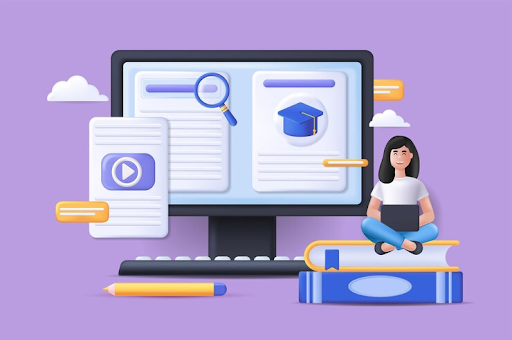Navigating the eLearning Development Process Strategies for Creating Effective Digital Learning Experiences

The educational sector has significantly evolved, coming the path from snail-mail courses to comprehensive digital training with remote access. The evolution simplified the educational process and provided students with extra opportunities. So, today, eLearning is no longer a novelty; it’s a quickly developing industry.
eLearning continues to gain strength and popularity in the corporate sector. Businesses implement eLearning techniques to train their staff, improve workforce efficiency, and streamline workflow processes. So, we’re going to consider the eLearning process and clarify all the related issues.
What is eLearning?
eLearning is a kind of educational training held online. It can be applied to any type of educational setting, such as corporate training, academic education, skill development courses, etc. The widespread installation of PCs and the introduction of Internet technologies became driving forces for the adoption of this educational method. The COVID-19 pandemic only accelerated the process, contributing to the introduction of eLearning in different spheres.
Since the popularity of passing training courses at a distance gains popularity, companies and businesses tend to implement such solutions for their workflows, which raises the demand for eLearning software on the market. Thus, specialized IT agencies appear. An eLearning software development company is an easy way to get high-quality professional solutions for your cases. Skilled specialists develop high-quality software for clients’ needs, taking into account their demands.
The high popularity of online training courses allowed enterprises to develop Web-based tutorials and remote lessons to improve knowledge and keep up with the latest tendencies in their spheres. Thus, educational software development is a popular direction in the IT industry. Regardless of the type of the final product and the sphere of application, each eLearning development process consists of the following stages:
1. Analysis Phase
Before software engineers get down to the development of eLearning software, they should clearly understand its objectives. Thus, a thorough analysis of a field is required to reach a deep understanding of the project and the set tasks. This is why each team of software developers has a business analyst whose direct responsibility includes the assessment of the subject to define project objectives.
Employees get all the needed information about the needed courseware and study analytics to write a detailed tech task for developers. This stage comes as a preparatory one; however, it’s of great significance for any development since it’s impossible to design high-quality software with the recognition of its purposes and tasks.
The obtained information is gathered, analyzed, and united in the tech task, based on which future curses are created. At this very stage, analysts define what information must be reflected in courseware. They greatly communicate with clients to find out their needs and satisfy their demands by developing tailored training software.
2. Design Phase
Next, the development process moves further to structuring the curriculum and storyboard creation. Here, designers come into play. Based on the obtained tech task, they create the visual part of the software to make it interactive and user-oriented. Their task includes the development of pages, blocks of information, presentations, multimedia, and virtual layouts. In other words, they are responsible for how the educational program will look like. At this stage, designers use the following tools:
- wireframing;
- mind mapping;
- storyboarding;
- action mapping.
This stage is important since the easiness of information perception and memorizing depends on interface intuitiveness. Thus, designers should seek proper ways and combine both textual, visual, and interactive tools to ensure easy and quick information perception.
3. Development Phase
Finally, a team gets down to the development. Software engineers use eLearning authoring tools to create content. Modern technologies and advanced digital solutions are applied to ensure the smooth functioning of an educational platform.
Here, developers try to implement the latest achievements in the IT industry to make software scalable and adaptive. They integrate diverse modules and equip software with built-in tools to ensure convenient and easy handling.
4. Implementation Phase
Put the final product into practice to make sure that it works correctly. Delivery of the course via Learning Management Systems (LMS) is done to provide a client with the product, after which real users can get down to training.
5. Evaluation Phase
However, once educational software is put into operation, the work of the development team is not finished. Specialists continue monitoring software performance to evaluate its ROI and measure crucial metrics.
Specialists pay attention to the response speed, the number of accepted users at a time, compatibility with different devices (mobile and desktop), geo, user feedback, and other aspects. The analysis of this information helps them assess software efficiency and convenience and make adjustments if needed.
What is eLearning Software?
Finally, let’s answer the question “What is eLearning software?” and define its role in digital education. eLearning software allows for improving and simplifying the training process, providing students with all the needed materials and tutorials for upgrading their knowledge bases.
These tailored programs are designed to satisfy the educational demands in particular spheres by gathering information about a narrow specialization. Training software is usually targeted at students of particular domains or spheres; Such programs pass certification to guarantee compliance with the set educational standards and norms. The most advanced examples offer simulation that helps master the obtained knowledge not only in theory but also in practice.
To sum up, note that digital technologies and IT tools have come to simplify the educational process. Nowadays, employees can pass training courses remotely and have access to any material at a distance. The integration of eLearning software into business workflow allows for improving performance and efficiency, simplifying progress monitoring, and ensuring control for employee competence. Thus, the use of digital corporate tutorials comes as a helpful and effective tool for modern business running.





